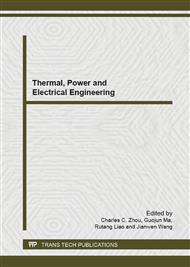[1]
Yanbing Guo, Haijun Zhao, Heyi Liu. Hydraulic Analysis of Product Pipeline [J]. Pipeline Technique and Equipment, 2010 (004): 57-59. (In Chinese)
Google Scholar
[2]
Guoquan Zhang, Kai Liu. Surge Analysis on Products Oil Pipeline [J]. Oil & Gas Storage And Transportation, 2006, 25(12): 61-63. (In Chinese)
Google Scholar
[3]
Wenxi Tian, G.H. Su, Gaopeng Wang a, et al.. Numerical simulation and optimization on valve-induced water hammer characteristics for parallel pump feed water system. Annals of Nuclear Energy 35 (2008): 2280-2287.
DOI: 10.1016/j.anucene.2008.08.012
Google Scholar
[4]
Xupeng Fang, Xiong Wei et al.. Study on the Transient Flow Control of Long-distance Oil Pipeline [J]. OGST, 2009, 28(2): 26-30. (In Chinese)
Google Scholar
[5]
Saikia M.D., Sarma A.K.. Simulation of water hammer flows with unsteady friction factor [J]. Arpn Journal of Engineering and Applied Sciences, 2006, 1(4): 35-40.
Google Scholar
[6]
Larkin B K. Some stable explicit difference approximations to the diffusion equation [J]. Math. Comp, 1964, 18: 196-202.
DOI: 10.1090/s0025-5718-1964-0164450-x
Google Scholar
[7]
M.H. Afshar, M. Rohani, R. Taheri. Simulation of transient flow in pipeline systems due to load rejection and load acceptance by hydroelectric power plants. International Journal of Mechanical Sciences 52 (2010): 103-115.
DOI: 10.1016/j.ijmecsci.2009.10.014
Google Scholar
[8]
Briley W R, McDonald H. Solution of the multidimensional compressible Navier-Stokes equations by a generalized implicit method [J]. Journal of Computational Physics, 1977, 24(4): 372-397.
DOI: 10.1016/0021-9991(77)90029-8
Google Scholar
[9]
Briley W R, McDonald H. An overview and generalization of implicit Navier–Stokes algorithms and approximate factorization [J]. Computers & fluids, 2001, 30(7): 807-828.
DOI: 10.1016/s0045-7930(01)00030-5
Google Scholar
[10]
Greyvenstein G P. An implicit method for the analysis of transient flows in pipe networks[J]. International journal for numerical methods in engineering, 2001, 53(5): 1127-1143.
DOI: 10.1002/nme.323
Google Scholar
[11]
M. Rohani, M.H. Afshar. Simulation of transient flow caused by pump failure: Point-Implicit Method of Characteristics. Annals of Nuclear Energy 37 (2010): 1742-1750.
DOI: 10.1016/j.anucene.2010.07.004
Google Scholar
[12]
K.H. Asli, Faig Bakhman Ogli Naghiyev, A. K. Haghi. Some aspects of physical and numerical modeling of water hammer in pipelines. Nonlinear Dyn 60 (2010): 677-701.
DOI: 10.1007/s11071-009-9624-7
Google Scholar
[13]
A. Khamlichi, L. Jezequel, F. Tephany. Elastic-plastic water hammer analysis in piping systems. Wave Motion 22 (1995): 279-295.
DOI: 10.1016/0165-2125(95)00025-e
Google Scholar
[14]
A. Riasi, A. Nourbakhsh, M. Raisee. Energy dissipation in unsteady turbulent pipe flows caused by water hammer. Computers & Fluids 73 (2013): 124-133.
DOI: 10.1016/j.compfluid.2012.12.015
Google Scholar
[15]
Dan Jiang, Songjing Li, Kevin A. Edge, Wen Zeng. Modeling and simulation of low pressure oil-hydraulic pipeline transients. Computers & Fluids 67 (2012): 79-86.
DOI: 10.1016/j.compfluid.2012.07.005
Google Scholar


